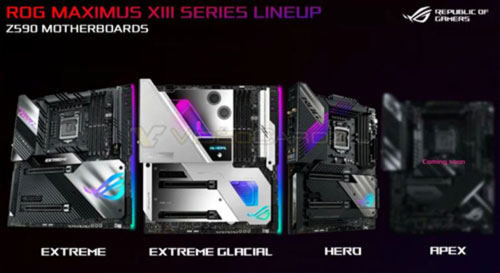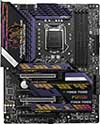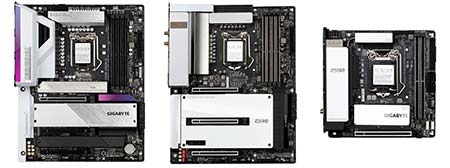Taipei, Taiwan, January 14th, 2021 – GIGABYTE TECHNOLOGY Co. Ltd, a leading manufacturer of motherboards and graphics cards, today announced the new Z590 VISION series motherboards for creators which power the 11th Gen Intel® Core™ processors. The exclusive design of VisionLINK and VisionLINK TB enables the simple connection to pen displays with only one USB Type-C® cable, releasing creators from the mess of transmission cables and switches to a neat space. Featuring an optimized power design, thermal design, superior connectivity and high quality components, GIGABYTE Z590 VISION series motherboards provide the remarkable platform for creators.
The VisionLINK technology allows for data and video transmission based on USB Type-C® Interface and it provides power delivery up to 60W. VisionLINK technology lets creators not only without cable clutter, but also the benefit of data, video, and power charging at the same time. One USB Type-C® cable connected, turn the workspace into neat and tidy. VisionLINK TB is an advanced version of VisionLINK technology. It is based on Thunderbolt™ 4 delivers 40Gb/s high-bandwidth speeds, data transferring, video signal, 60W power charging, and daisy chain function to support up to 10 devices connection.
The Z590 VISION series motherboards keep the VISION white styling with exclusive hardware design to provide creators with an improved working efficiency. The Z590 VISION series motherboards inherit GIGABYTE’s leadership in motherboard power design and VRM thermal design, using up to 12-phase direct power design paired with highly durable DrMOS to provide the best power delivery. Solid power pin connectors on the Z590 VISION series motherboards ensure that the power delivery is stable while reducing excess heat during high workload to prevent throttling, and make the processor more stable to avoid downtime due to an unstable power supply. With the new design of the fins-array, direct-touch heat-pipe, large heat sinks and Smart Fan 6, it not only strengthens the thermal effect, but also takes into account the appearance design, allowing the GIGABYTE Z590 VISION motherboards to be both stylish and thermally efficient.
The memory circuits of GIGABYTE Z590 VISION motherboards are embedded within the PCB ground layers while the metal outer layer of the PCB reduces electromagnetic interference so those using dual channel configuration can enjoy high-speed, stable overclocked RAM performance boost above XMP 4800MHz. GIGABYTE Z590 VISION motherboards use PCIe 4.0 grade of PCBs, PCIe slots, M.2 slots, and controllers for the highest bandwidth quality. The select Z590 VISION motherboards equip with three PCIe 4.0 M.2 slots which the trace layout comes directly from CPU for the NVMe M.2 SSD, and offers and extreme sequential read speed of more than 20000 MB/s in Windows RAID 0 mode.
Besides taking the lead to implement Thunderbolt™ 4 onboard, GIGABYTE Z590 VISION motherboards also adopt robust expansion for content creators , which includes SuperSpeed USB3.2 Gen2x2, Intel® 2.5G Ethernet, and High Fidelity audio output expansion interface. The Intel® 2.5Gbps Ethernet controller brings ultra-fast connectivity that is 2.5X faster than Gigabit Ethernet. Also, the lineup implements an Intel® WiFi 6 802.11ax network adapter to provide Gigabit level wireless network, and paired with high-gain Wi-Fi smart antenna to deliver up to 2.4Gbps transmission speed which offers smoother streaming videos, fewer dropped connections, and more stability. To feature with dual Ethernet LAN and WiFi for creators to have a flexible configuration with high bandwidth and low latency access connectivity. The newest GIGABYTE VISION DRIVE perfectly matches the 20 Gbps high speed transfer of USB 3.2 Gen2x2 to meet the needs of ultra-fast storage from creators.
GIGABYTE Z590 VISION series motherboards are equipped with the high SNR audio engine ALC4080 and the WIMA FKP2 studio-grade audio capacitors to deliver studio-grade audio. GIGABYTE’s exclusive design with DTS:X® Ultra technology delivers high fidelity audio for the most immersive sound experience whether it’s for work or entertainment. From video editing to listening to music, the audio quality is indispensable.
Z590 VISION G features three PCIe x16 slots with one Gen4 x16 and two Gen3 x4 supported. There are four M.2 slots with PCIe 4.0/3.0 interface, and six SATA 6Gb/s ports. With the VisionLINK for connection of pen displays and the DP_In interface, the 3D performance of VGA cards can be shared to pen displays, which is suitable for enabling 2D design and entry-level 3D modeling.
Z590 VISION D holds two PCIe 4.0 slots of x16 and x8 interface, two PCIe 3.0 expansion slots of x4 and x1, three M.2 slots with PCIe 4.0/3.0 interface, and six SATA 6Gb/s ports. With the VisionLINK TB for connection of pen display and the DP_In interface, the performance of VGA cards can be shared to pen displays, which is more suitable for VFX, 3D compilation, 3D CAD, AI development, and edge deployment.
Z590I VISION D is the first ITX size motherboard of VISION series which is the top choice for mini PC to handle 2D and light-duty 3D computer-aided workloads in fields such as architecture and engineering. In addition to one PCIe 4.0 x16 slot, two PCIe 4.0/3.0 M.2 slots, and four SATA 6Gb/s ports onboard, Z590I VISION D also equips two Thunderbolt™ 4 ports which can deliver 40Gb/s high-bandwidth speeds, data transferring, video signal, 60W power charging, USB4™ specification compliance, and daisy chain function to support up to 10 devices connection. Heat dissipation is very critical to the mini PC. Z590I VISION D thermal’s solution provides a perfect balance between style and performance.
Z590 VISION series also implement the highly recognized durability and stability of GIGABYTE motherboards. The exclusive Q-Flash Plus feature allows users to flash a BIOS file without installing a CPU, RAM, GPU, and other peripherals. Creators now can concentrate on their creation under a stable system.







